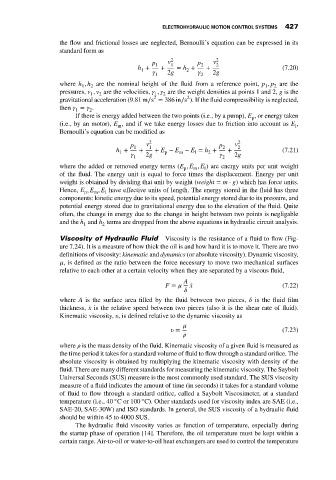Page 441 - Mechatronics with Experiments
P. 441
Printer: Yet to Come
October 9, 2014 8:41 254mm×178mm
JWST499-c07
JWST499-Cetinkunt
ELECTROHYDRAULIC MOTION CONTROL SYSTEMS 427
the flow and frictional losses are neglected, Bernoulli’s equation can be expressed in its
standard form as
p 1 v 2 1 p 2 v 2 2
h + + = h + + (7.20)
2
1
1 2g 2 2g
where h , h are the nominal height of the fluid from a reference point, p , p are the
2
1
2
1
pressures, v , v are the velocities, , are the weight densities at points 1 and 2, g is the
2
1
2
1
2
2
gravitational acceleration (9.81 m∕s = 386 in∕s ). If the fluid compressibility is neglected,
then = .
1
2
If there is energy added between the two points (i.e., by a pump), E , or energy taken
p
(i.e., by an motor), E , and if we take energy losses due to friction into account as E ,
l
m
Bernoulli’s equation can be modified as
p 1 v 2 1 p 2 v 2 2
h + + + E − E − E = h + + (7.21)
1 p m l 2
2g 2g
1 2
where the added or removed energy terms (E , E , E ) are energy units per unit weight
p m l
of the fluid. The energy unit is equal to force times the displacement. Energy per unit
weight is obtained by dividing that unit by weight (weight = m ⋅ g) which has force units.
Hence, E , E , E have effective units of length. The energy stored in the fluid has three
p m l
components: kinetic energy due to its speed, potential energy stored due to its pressure, and
potential energy stored due to gravitational energy due to the elevation of the fluid. Quite
often, the change in energy due to the change in height between two points is negligable
and the h and h terms are dropped from the above equations in hydraulic circuit analysis.
2
1
Viscosity of Hydraulic Fluid Viscosity is the resistance of a fluid to flow (Fig-
ure 7.24). It is a measure of how thick the oil is and how hard it is to move it. There are two
definitions of viscosity: kinematic and dynamics (or absolute viscosity). Dynamic viscosity,
, is defined as the ratio between the force necessary to move two mechanical surfaces
relative to each other at a certain velocity when they are separated by a viscous fluid,
A
F = ̇ x (7.22)
where A is the surface area filled by the fluid between two pieces, is the fluid film
thickness, ̇ x is the relative speed between two pieces (also it is the shear rate of fluid).
Kinematic viscosity, , is defined relative to the dynamic viscosity as
= (7.23)
where is the mass density of the fluid. Kinematic viscosity of a given fluid is measured as
the time period it takes for a standard volume of fluid to flow through a standard orifice. The
absolute viscosity is obtained by multiplying the kinematic viscosity with density of the
fluid. There are many different standards for measuring the kinematic viscosity. The Saybolt
Universal Seconds (SUS) measure is the most commonly used standard. The SUS viscosity
measure of a fluid indicates the amount of time (in seconds) it takes for a standard volume
of fluid to flow through a standard orifice, called a Saybolt Viscosimeter, at a standard
◦
◦
temperature (i.e., 40 C or 100 C). Other standards used for viscosity index are SAE (i.e.,
SAE-20, SAE-30W) and ISO standards. In general, the SUS viscosity of a hydraulic fluid
should be within 45 to 4000 SUS.
The hydraulic fluid viscosity varies as function of temperature, especially during
the startup phase of operation [14]. Therefore, the oil temperature must be kept within a
certain range. Air-to-oil or water-to-oil heat exchangers are used to control the temperature

